There’s something magical about stepping onto a trail, surrounded by nature’s beauty. Whether you’re a seasoned hiker or just starting, preparation is key to making the most of your adventure. I’ve spent over 15 years exploring trails, and I’m here to guide you—like your personal trail Sherpa—through the process of getting ready for a day hike.
From forgetting socks on a 12-mile trek to discovering the perfect gear, I’ve learned a lot through trial and error. This guide is designed to help you avoid common mistakes and ensure you’re equipped for any season or terrain. Safety is the foundation of every great hike, and with the right essentials, you’ll be free to enjoy every moment.
Think of this as your go-to checklist, tested and trusted by someone who’s been there. Let’s make sure your next hike is as enjoyable as it is memorable!
Key Takeaways
- Proper preparation ensures a safe and enjoyable hiking experience.
- Seasonal adaptability is crucial for comfort on the trail.
- Safety should always be your top priority.
- Real-world tested gear recommendations save time and effort.
- Learn from common mistakes to avoid unnecessary challenges.
Introduction to Day Hiking Essentials
Day hiking offers a unique blend of adventure and simplicity, making it accessible to everyone. Unlike casual neighborhood walks, a wilderness trek demands thoughtful preparation. I learned this the hard way during a hike I underestimated—it ended with me relying on an emergency bivvy to stay warm overnight.
That experience taught me the importance of the modern Ten Essentials. These items are the backbone of any successful hike, ensuring you’re ready for unexpected challenges. From navigation tools to first aid supplies, each piece of gear serves a critical purpose.
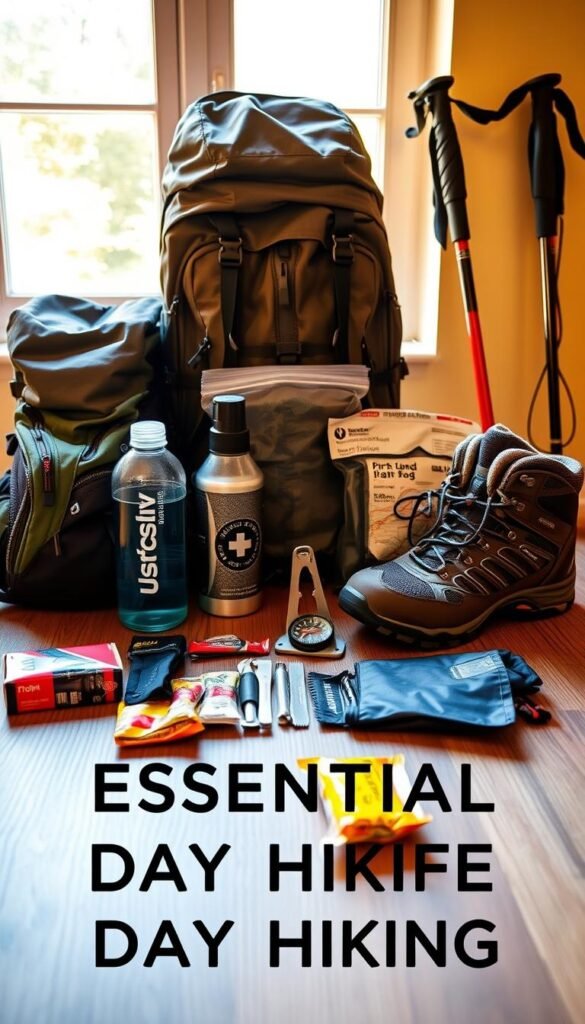
When choosing gear, I always consider the weight-to-utility ratio. Your pack should feel like a Swiss Army knife—compact yet versatile. This approach keeps you agile while ensuring you have what you need.
To make preparation easier, I’ve organized a checklist that’s both practical and intuitive. You can even download a printable PDF version for your next adventure. Proper preparation isn’t just about safety—it’s about peace of mind, allowing you to fully immerse yourself in the beauty of the trail.
Packing Essentials: What to Bring on a Day Hike
The key to a successful adventure lies in what you carry—and how you carry it. Over the years, I’ve fine-tuned my approach to ensure my pack is neither too heavy nor too light. It’s all about the Goldilocks principle: finding the perfect balance for comfort and preparedness.
My base weight varies with the seasons. In summer, I aim for around 10 pounds, while winter hikes push it closer to 15 pounds. This includes essentials like a lightweight tent, sleeping bag, and cooking gear. The trick is to adapt to the terrain and weather conditions.

Not all items are created equal. On a trip to the Smoky Mountains, I learned the hard way that a portable coffee maker was more luxury than necessity. In contrast, during a hike in Arches National Park, a multi-use bandana saved the day—serving as a towel, sun shield, and even a makeshift sling.
To stay organized, I use a modular packing system:
- Always: Navigation tools, first aid kit, and water.
- Sometimes: Extra layers, depending on the forecast.
- Seasonal: Snow spikes in winter, bug spray in summer.
This system ensures I’m ready for anything without overpacking.
My Sunday night routine is sacred. I lay out all my gear, check for wear and tear, and pack methodically. This ritual saved me when my backpack zipper broke mid-hike—I had a repair kit ready to go.
Weight distribution is crucial for comfort. Heavy items should sit close to your back, while lighter ones go on top. And don’t underestimate the power of multi-use tools. A bandana, for example, can be a lifesaver in countless ways.
Ultimately, the right gear transforms your hiking experience. It’s not just about surviving the trail—it’s about thriving on it.
Choosing the Right Clothing for Your Hike
The right clothing can make or break your hiking experience—trust me, I’ve learned this the hard way. One of my most embarrassing moments involved a pair of cotton socks on a chilly morning hike. By midday, my feet were soaked, cold, and blistered. That’s when I realized the importance of choosing the right fabrics and layers for the trail.
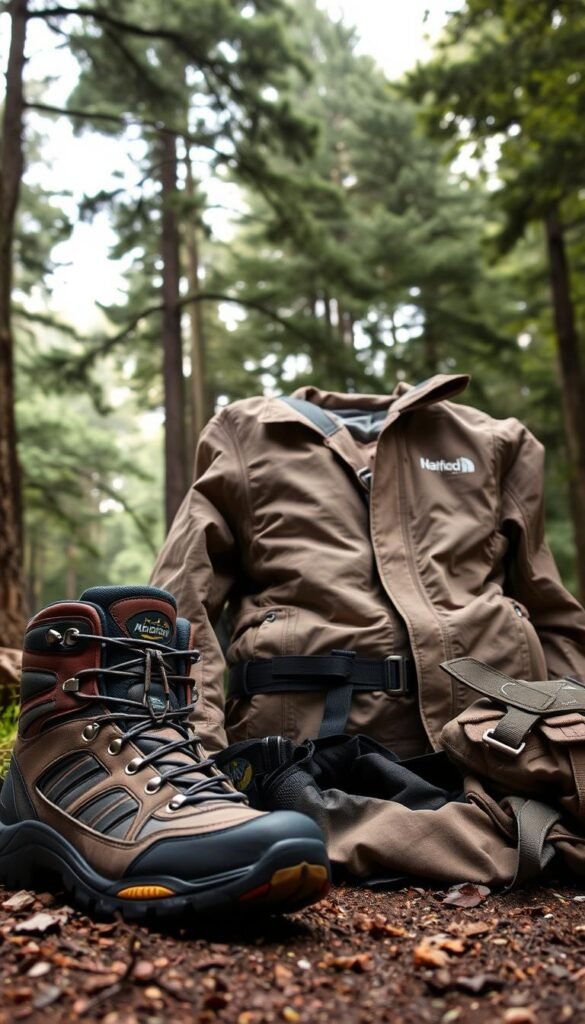
Base Layers and Moisture-Wicking Fabrics
Your base layer is your second skin. I’ve tested both merino wool and synthetic fabrics in various climates. In humid conditions, synthetics excel at wicking moisture, while merino shines in arid environments with its natural odor resistance. Either way, avoid cotton—it’s a recipe for discomfort.
Insulating Layers for Variable Weather
Weather can change in an instant, so layers are your best friend. Here’s my go-to system:
- 30-50°F: Base layer + fleece jacket.
- 10-30°F: Add a down or synthetic insulated jacket.
- Below 10°F: Include a heavyweight parka.
This system keeps me comfortable in any condition.
Rain Gear and Wind Protection
When it comes to rain and wind, your jacket is your shield. I’ve debated between the Patagonia Torrentshell and the Outdoor Research Helium for years. Here’s a quick comparison:
| Feature | Patagonia Torrentshell | Outdoor Research Helium |
|---|---|---|
| Weight | 11.9 oz | 6.4 oz |
| Packability | Good | Excellent |
| Durability | High | Moderate |
| Price | $149 | $159 |
Wind chill can be surprising—even a 10 mph breeze can drop the temperature by 15°F. That’s why I always carry a windproof layer. And don’t forget secret pockets for essentials like snacks and a map.
For multi-day hikes, odor control is crucial. Merino wool resists smells, while synthetic fabrics benefit from a quick rinse in a stream. And yes, my hiking wardrobe is a mix of “ugly but functional” colors—bright hues for visibility and dark shades for dirt camouflage.
Footwear: The Foundation of a Good Hike
Your feet are your most valuable asset on the trail—treat them right. Over the years, I’ve learned that the right pair of shoes can make or break your adventure. I’ve tested everything from rugged boots to lightweight trail runners, and each has its place in my gear collection.
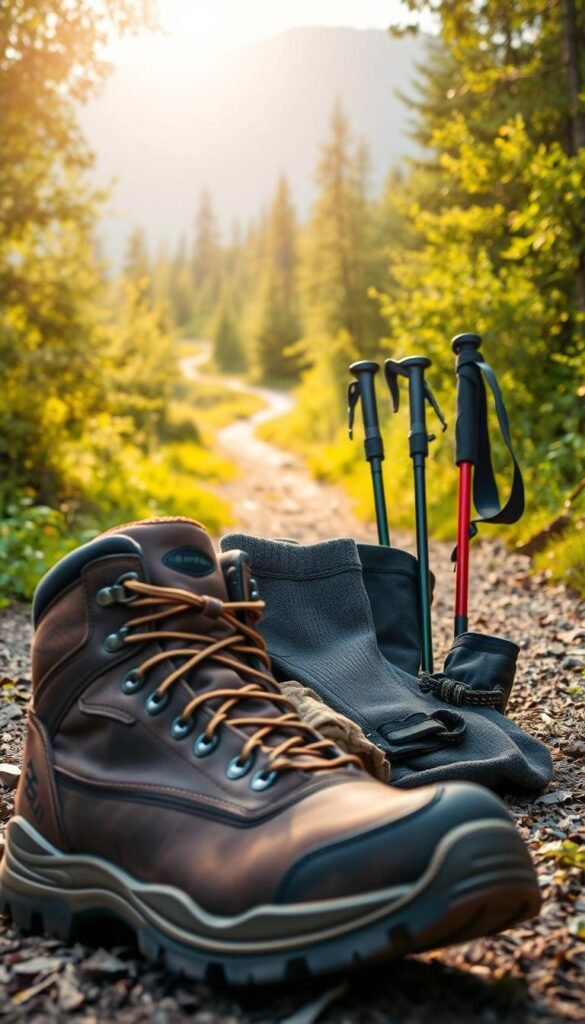
Hiking Shoes vs. Boots vs. Trail Runners
Choosing between hiking shoes, boots, and trail runners depends on the terrain and your personal preferences. Hiking boots are my go-to for rugged trails—they offer ankle support and stability, especially on uneven paths. For shorter, well-maintained trails, I opt for lighter, more flexible trail shoes. And when I’m aiming for speed on moderate terrain, trail runners are my best bet.
Break-in periods vary by brand. My Salomon boots took a week to feel comfortable, while my Merrell trail runners were ready to go out of the box. Always test your footwear before a long hike to avoid blisters.
Choosing the Right Socks
Socks are just as important as shoes. I’ve developed a blister prevention protocol after hiking the Appalachian Trail—moisture-wicking socks are a must. I’ve experimented with toe socks, and while they’re controversial, they’ve saved me from blisters on long hikes.
When it comes to durability, I’ve compared Darn Tough and Smartwool. Both are excellent, but Darn Tough’s lifetime warranty gives it the edge. Pair them with the right shoes, and your feet will thank you.
Here are a few tips to keep in mind:
- Tread patterns: Match them to the terrain—deeper treads for muddy trails, smoother ones for rocky paths.
- Lacing techniques: Use heel-lock lacing to prevent slippage.
- Waterproofing: Maintain it regularly to keep your feet dry.
For more detailed advice on hiking boots, check out this guide. Your footwear is the foundation of every step you take—choose wisely, and your hike will be a success.
Essential Gear for Day Hiking
Every hike begins with the right gear—choosing wisely can elevate your experience. Over the years, I’ve tested countless products, from daypacks to headlamps, and learned what truly makes a difference on the trail. Let’s dive into the essentials that will keep you prepared and comfortable.
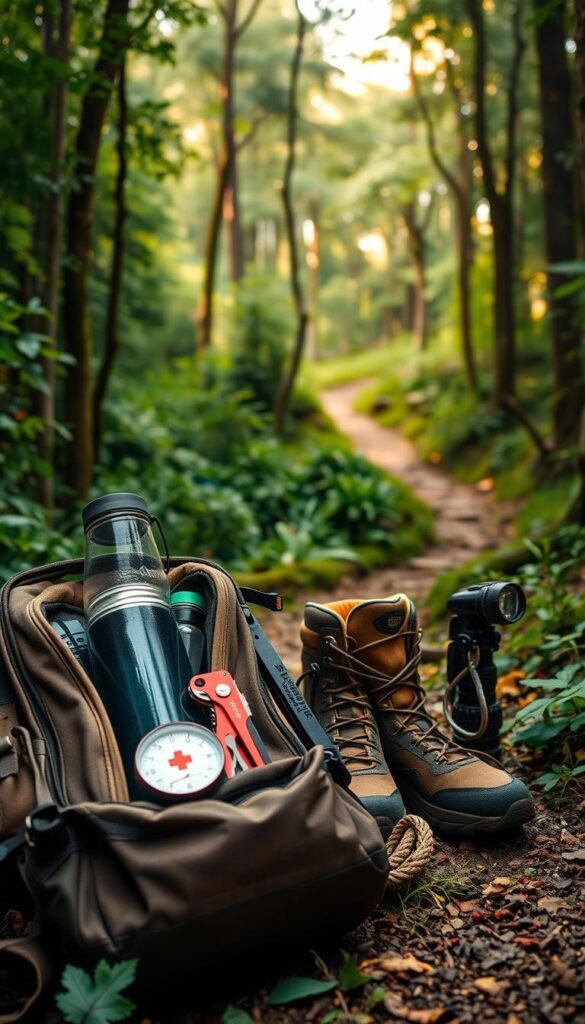
Daypacks and Hydration Systems
Your bag is your command center on the trail. I’ve had a long-standing debate between Osprey and Gregory packs. Osprey’s anti-gravity suspension system feels like a dream on long hikes, while Gregory’s adjustable fit offers unmatched customization. Whichever you choose, ensure it has a sturdy hip belt—it’s a game-changer for weight distribution.
Hydration is non-negotiable. I always calculate my water needs based on distance and weather. A general rule: carry one liter for every two hours of hiking. Hydration bladders are my go-to for convenience, but don’t forget to clean them regularly to avoid mold.
Trekking Poles for Stability
Trekking poles are more than just walking sticks—they’re your stability on uneven terrain. I’ve tested collapsible poles extensively, and while they’re lightweight, durability can be hit or miss. Black Diamond’s aluminum poles have never let me down, even on rocky descents.
Did you know trekking poles can double as tent supports or even a makeshift splint? They’re versatile tools that deserve a spot in your gear lineup.
Headlamps and Illumination
When the sun sets, a reliable headlamp becomes your best friend. I’ve compared Petzl and Black Diamond models extensively. Petzl’s reactive lighting adjusts to your surroundings, while Black Diamond’s Spot series offers unbeatable brightness. Both are excellent choices for night hikes.
Pro tip: Always carry extra batteries or a backup light source. You never know when you’ll need it.
Navigation Tools for Safe Hiking
Navigating the wilderness is both an art and a science—get it right, and the trail becomes your playground. I’ve had my share of misadventures, like the time I relied solely on my smartphone and ended up wandering in circles for hours. That experience taught me the value of having reliable navigation tools and knowing how to use them.
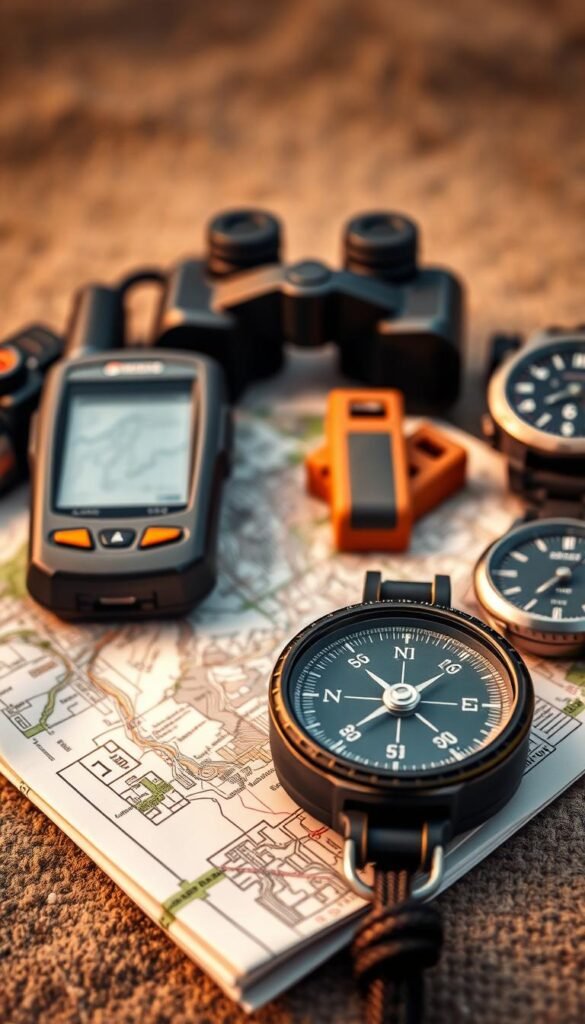
Maps and Compasses
A map and compass are timeless essentials. I’ve learned to adjust for declination quickly—it’s a simple trick that can save you from heading in the wrong direction. Waterproofing your map is another hack I swear by. I’ve used everything from zip-lock bags to laminating sheets to keep my maps intact during rainstorms.
Reading a topographic map is a skill worth mastering. It’s not just about knowing where you are—it’s about understanding the terrain ahead. I’ve spent countless hours practicing this, and it’s made a world of difference on tricky trails.
GPS Devices and Apps
When it comes to GPS, I’ve tested both Gaia and AllTrails extensively. Gaia excels in offline use and detailed topo maps, while AllTrails shines with its user-friendly interface and community reviews. Here’s a quick comparison:
| Feature | Gaia GPS | AllTrails |
|---|---|---|
| Offline Maps | Yes | Limited |
| Topo Maps | Detailed | Basic |
| Community Reviews | Moderate | Extensive |
| Price | $39.99/year | $35.99/year |
While technology is convenient, I always carry a backup. A signaling mirror has saved me more than once—it’s lightweight and effective in emergencies. Battery conservation is another critical strategy. I turn off unnecessary features and carry a portable charger for longer hikes.
Controversial as it may be, I believe in balancing tech with traditional tools. A compass doesn’t run out of batteries, and a map doesn’t lose signal. Combining these with a GPS ensures you’re prepared for anything the trail throws your way.
Hydration and Nutrition on the Trail
Fueling your body properly can turn a grueling hike into an enjoyable adventure. I’ve had my share of mishaps—like the time I underestimated my water needs on a scorching summer hike. By mile six, I was dizzy, nauseous, and relying on my hiking partner to share their last sip. That day taught me the importance of planning ahead.

Water Bottles and Hydration Bladders
Choosing between a hydration bladder and a water bottle depends on your preferences. Bladders are great for hands-free sipping, but they can be tricky to clean. Bottles, on the other hand, are easier to refill and monitor your intake. I’ve used both extensively and now carry a combination—a bladder for convenience and a bottle for backup.
Here’s my secret electrolyte mix formula: a pinch of salt, a squeeze of lemon, and a teaspoon of honey. It’s lightweight, natural, and keeps me energized without the sugar crash of store-bought mixes.
Energy-Boosting Snacks and Meals
When it comes to snacks, calorie density is key. I always pack nuts, dried fruit, and energy bars—they’re lightweight but pack a punch. For longer hikes, I’ve experimented with dehydrated meals. While they’re not gourmet, they’re surprisingly filling and easy to prepare.
Here are a few tips I’ve picked up over the years:
- Bear-safe storage: Use odor-proof bags and hang your food at least 10 feet off the ground.
- Carb vs. protein timing: Carbs are great for quick energy, while protein helps with recovery. I snack on carbs during the hike and save protein-rich food for the end.
- Weirdest trail snacks: I’ve tried everything from beef jerky to seaweed chips. My favorite? Peanut butter stuffed pretzels—they’re oddly satisfying.
Proper hydration and nutrition aren’t just about survival—they’re about thriving on the trail. With the right approach, you’ll feel stronger, more focused, and ready to tackle any challenge.
Sun Protection and Weather Preparedness
The sun can be both a friend and a foe on the trail—knowing how to protect yourself is crucial. I’ve had my share of painful sunburns, like the time I underestimated the desert sun and ended up with peeling skin for days. That experience taught me the importance of proper sun protection and staying prepared for changing weather conditions.

Sunscreen and UPF Clothing
When it comes to sunscreen, I’ve tested everything from zinc oxide to chemical formulas. Zinc oxide is my go-to for sensitive skin—it’s natural and provides broad-spectrum protection. Chemical sunscreens, on the other hand, are lighter and easier to apply but may irritate some skin types.
UPF clothing is a game-changer. I’ve compared brands like Columbia and Patagonia, and the difference in fabric effectiveness is noticeable. UPF 50+ fabrics block 98% of UV rays, keeping you cool and protected. Don’t forget to reapply sunscreen every two hours—I set reminders on my watch to stay on track.
Sunglasses and Hats
Your eyes need protection too. Polarized sunglasses reduce glare and improve visibility, especially near water or snow. I’ve tested Oakley and Ray-Ban models—both offer excellent UV protection and durability.
A good hat is essential. I prefer wide-brimmed hats for maximum coverage, but if you’re hiking in windy conditions, a baseball cap with a neck flap works wonders. Here’s a quick comparison of my favorites:
| Feature | Wide-Brim Hat | Baseball Cap with Neck Flap |
|---|---|---|
| Coverage | Full face and neck | Face and neck (with flap) |
| Wind Resistance | Moderate | High |
| Packability | Bulky | Compact |
Lastly, don’t overlook unexpected shade sources like trees or rock formations. They can provide a quick break from the sun’s intensity. With the right gear and preparation, you’ll stay safe and comfortable no matter what the trail throws at you.
First Aid and Emergency Supplies
When you’re miles from civilization, being ready for emergencies isn’t optional—it’s essential. Over the years, I’ve refined my first aid kit to include items that address both common injuries and unexpected crises. From blisters to broken bones, the right supplies can make all the difference.
Basic First Aid Kit Essentials
My kit has evolved significantly since my early hiking days. What started as a simple bandage collection now includes items like SAM splints, which I’ve used for everything from stabilizing sprains to creating makeshift splints for broken tent poles. Wound closure is another area where I’ve learned to adapt—butterfly bandages work wonders, but I always carry a small tube of super glue for emergencies.
Here’s what I never leave without:
- Adhesive bandages: For blisters and minor cuts.
- Antiseptic wipes: To clean wounds and prevent infection.
- Pain relievers: Ibuprofen or acetaminophen for headaches or muscle pain.
- Tweezers: For removing splinters or ticks.
Emergency Blankets and Bivvy Sacks
When it comes to staying warm in an emergency, I’ve debated between bivvy sacks and space blankets. Bivvy sacks are more durable and provide better insulation, while space blankets are lightweight and compact. Here’s a quick comparison:
| Feature | Bivvy Sack | Space Blanket |
|---|---|---|
| Weight | 8 oz | 2 oz |
| Durability | High | Low |
| Insulation | Excellent | Moderate |
Signaling devices are another must-have. I carry a whistle and a small mirror—both are lightweight and effective for attracting attention. Wilderness medicine training has also been invaluable. I’ve taken courses through NOLS, and I highly recommend them for anyone serious about hiking safety.
For pet owners, don’t forget to pack pet-specific aid items like paw balm and a small muzzle. Even the friendliest dog can act unpredictably when injured. Being prepared isn’t just about gear—it’s about knowing how to use it when it matters most.
Personal Items and Extras
The little things often make the biggest difference on the trail—especially when it comes to personal items. Over the years, I’ve learned that forgetting even the smallest items can lead to uncomfortable situations. Take, for example, the time I forgot toilet paper on a remote hike. Let’s just say, I’ve never made that mistake again.
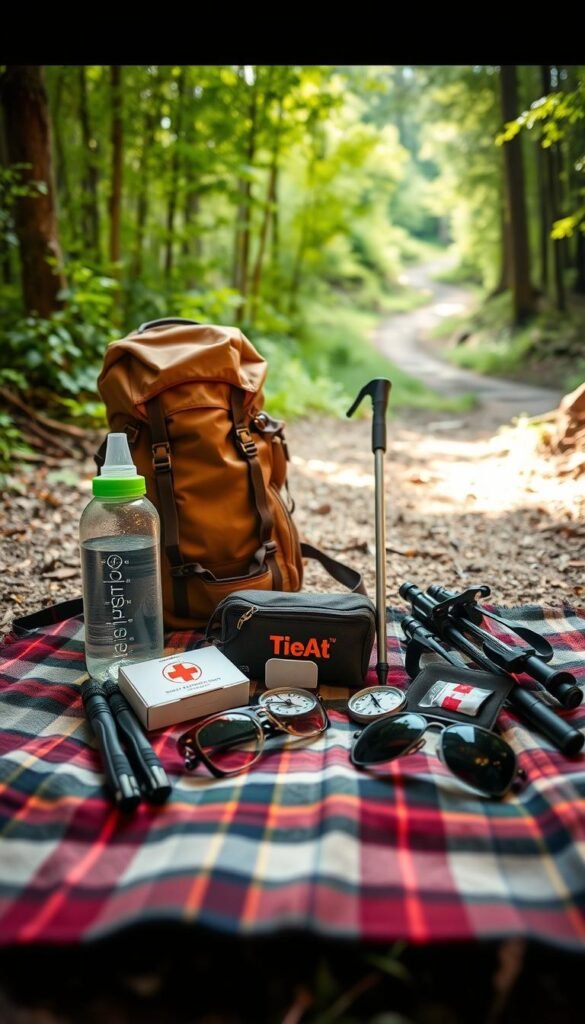
From insect repellent to multitools, these extras are the unsung heroes of any successful hike. They’re the items you might not think about until you need them, but when you do, you’ll be glad you packed them.
Insect Repellent and Hygiene Products
When it comes to insect repellent, I’ve tested both DEET and natural alternatives. DEET is highly effective, especially in bug-heavy areas, but it can be harsh on the skin. Natural options, like citronella or eucalyptus oil, are gentler but may need more frequent application.
Hygiene is another critical factor. Biodegradable soap is a must for minimizing environmental impact. I’ve tried several brands, and Dr. Bronner’s is my go-to—it’s versatile and eco-friendly. Don’t forget a small towel and hand sanitizer for quick clean-ups.
Multitools and Repair Kits
A good knife or multitool is indispensable on the trail. I’ve customized my Leatherman to include a small saw blade and extra screwdrivers—it’s saved me more times than I can count. Repair kits are equally important. Duct tape, zip ties, and a sewing kit can fix everything from torn clothes to broken gear.
Here’s a quick comparison of multitool features:
| Feature | Leatherman Wave+ | Gerber Suspension |
|---|---|---|
| Weight | 8.5 oz | 9.5 oz |
| Tools Included | 18 | 12 |
| Price | $119.95 | $49.95 |
For waste management, I always carry a small trowel and odor-proof bag. It’s not just about convenience—it’s about respecting the environment. And if you’re hiking in bear country, bear spray is non-negotiable. Practice using it before your trip to ensure you’re prepared.
These personal items might seem minor, but they’re the key to a comfortable and safe hiking experience. Pack wisely, and you’ll be ready for anything the trail throws your way.
Seasonal Considerations for Day Hiking
Seasonal changes bring unique challenges and opportunities for hikers. Whether you’re facing icy trails or scorching heat, adapting your gear and strategies is essential. I’ve learned this the hard way—like the time I underestimated winter’s bite and nearly faced hypothermia. Let’s dive into how to stay prepared for every season.
Winter Hiking Gear
Winter hikes can be magical, but they demand extra caution. My close call with hypothermia taught me the importance of proper layers. Here’s my go-to formula: a moisture-wicking base layer, an insulating mid-layer, and a windproof outer shell. This system keeps me warm without overheating.
Foot traction is another critical factor. I’ve tested microspikes from Kahtoola and Hillsound—both are excellent, but Kahtoola’s durability stands out. Don’t forget to protect your water supply; I’ve had electrolytes freeze solid, leaving me dehydrated. Insulated bottles or hydration bladders with insulated tubes are lifesavers.
Summer Hiking Tips
Summer hikes bring their own set of challenges. Heat exhaustion can sneak up on you—look out for signs like dizziness, nausea, and excessive sweating. I’ve developed a summer foot care regimen: moisture-wicking socks, breathable shoes, and regular breaks to air out my feet.
Sun protection is non-negotiable. I’ve compared sun shirts from Columbia and Patagonia—Columbia’s breathability is unmatched. Cooling towels are another summer essential. I’ve tested Mission and Frogg Togg brands; Mission’s quick cooling effect is impressive.
Adapting to the weather and choosing the right clothes can make all the difference. With the right approach, you’ll be ready to tackle any season with confidence.
Hiking with Kids and Pets
Exploring the outdoors with kids and pets can turn a simple hike into an unforgettable adventure. Whether you’re introducing your little ones to nature or bringing your furry friend along, preparation is key. I’ve had my share of mishaps—like the time my dog decided to chase a squirrel off the trail—but these experiences taught me valuable lessons about safety and fun.
Essential Gear for Children
When hiking with kids, the right gear makes all the difference. I’ve tested various child carriers, and the Osprey Poco stands out for its comfort and durability. It’s adjustable, has ample storage, and even includes a sunshade—perfect for long hikes.
Snacks are a great motivator for little hikers. I’ve found that packing a mix of healthy options and treats keeps them energized and happy. Here’s my go-to snack list:
- Trail mix: A blend of nuts, dried fruit, and chocolate.
- Fresh fruit: Apples and bananas are easy to carry.
- Granola bars: Look for low-sugar options.
Navigation can also be a fun learning opportunity. I’ve turned map reading into a game, challenging my kids to find landmarks or count trail markers. It keeps them engaged and teaches valuable skills.
Preparing Your Dog for the Trail
Hiking with your dog requires extra planning. Start with a good pairof booties to protect their paws from rough terrain. I’ve tried Ruffwear and Kurgo—both are durable and easy to put on.
Leash laws vary by location, so always check regulations before heading out. I prefer a hands-free leash for better control, especially on steep or rocky paths. Here’s what I include in my pet first aid kit:
- Paw balm: To soothe cracked pads.
- Tweezers: For removing thorns or ticks.
- Bandages: For minor cuts or scrapes.
Collapsible bowls are another must-have. I’ve tested several brands, and Outward Hound’s design is both lightweight and sturdy. Remember to bring enough water for both you and your pet—hydration is crucial for everyone on the trail.
With the right preparation, hiking with kids and pets can be a rewarding experience. It’s a great way to create lasting memories while enjoying the beauty of nature together.
Conclusion: Ready for Your Next Adventure
Every step on the trail is a chance to grow, learn, and connect with nature. Preparation transforms a simple day hike into a journey of discovery. Start small, build your skills gradually, and always carry a little extra—whether it’s water, snacks, or a first aid kit. It’s better to have it and not need it than the other way around.
Hiking with experienced friends or mentors can make all the difference. They’ll share tips, keep you safe, and inspire you to explore further. For more beginner-friendly advice, check out this guide on essential gear to ensure you’re ready for any adventure.
As you lace up your boots and hit the trail, remember: every hike is a story waiting to be written. The mountains, forests, and rivers are calling—what will your next chapter be?



0 Comments